View in other NatureServe Network Field Guides
NatureServe
Montana
Utah
Wyoming
Idaho
Wisconsin
British Columbia
South Carolina
Yukon
California
New York
Wishbone Moonwort - Botrychium furculatum
Other Names:
Botrychium "adnatum" [unpublished], Botrychium pallidum [misapplied]
State Rank Reason (see State Rank above)
Botrychium furculatum has been documented from more than 65 locations throughout its range with many populations numbering more than 100 individuals (Popovich et al. 2020). From 1997 to 2010, 18 observations in 7 areas of northwestern Montana have been documented. Population counts have found from 1 to 30 individuals. Popovich, Farrar, and Gilman (2020) believe the viability of Botrychium furculatum is secure at a global scale, though it may be locally rare in portions of its range. Current data on population sizes and threats along with better mapping is needed in order to reassess the status of Botrychium furculatum in Montana.
General Description
note: The publication by Popovich, Farrar, and Gilman (2020) should be used to properly identify this species as it contains a more thorough description with necessary photographs, drawings, and a key to similar species.
PLANTS: Herbaceous perennials with fleshy leaves, stems, and roots. A single stem with a single, pinnately divided sterile leaf blade (trophophore) and a fertile, spore-bearing leaf (sporophore) that dies back once spores are released. Mycorrhizal fungi live within the cells of its roots (endomycorrhizal). The underground stem is vertical, unbranched, and bears from 5 to 18 or more roots. Roots are up to 1.2 mm in width. Gemmae are absent or few and attach directly to the underground stem. The belowground apical bud ranges from 2.3 to 7.4 cm below the soil surface. Sources: Popovich et al. 2020; Lesica et al. 2012
TROPHOPHORE: A single, erect leaf ranges from (0.6) 1.2-3.6 (5.3) cm long and is dichotomously divided into (2) 4-5 (7) pinna pairs. The leaf lacks hairs (glabrous) but may be glaucous. Leaf color ranges from pale green, whitish-green, or yellow-green to extremely pale yellow-white; it is rarely glaucous blue-green. The outline of the pinna is fan-shaped to spatulate, sometimes more or less rhombic and often asymmetrical. The stalk of the trophophore often bows outwardly, joing the sporophore's stalk in a spreading to narrow wishbone-like "junction". The lowest most pairs of pinnae usually clasp the sporophore stalk at maturity. Pinnae (leaflets) ascend or spread. The lowest pinnae are usually well-spaced while the upper pinnae may overlap. The lowest pinnae are largest and gradually decrease upwards in size and lobing. Pinnae are broadly attached (short or fused) to the rachis, or sometimes is decurrent. The margins of the pinnae do not overlap the rachis. Pinnae range from palmately lobed to entire, Lobes are often asymmetrical and shallow, sometimes cleft more than half-way to the pinnae's base. The margin of the pinnae range from crenate to erose to lacerate, but in smaller plants tend to be entire. Often some pinnae appear malformed, unevenly truncate, or terminate abruptly as if cut, or stubby. Basal pinnae sometimes bear sporangia on their margins. Source: Popovich et al. 2020
SPOROPHORE:
Erect, (1.0) 1.9-7.6 (10.3) cm long with a stalk that is (0.2) 0.8-3.9 (6.1) cm long. Sometimes the sporophore arches away from the trophophore. Sporophore is (1.0) 1.4-2.6 (3.4) times the length of the trophophore. The stalk of the sporophore is (0.2) 0.5-1.3 (1.9) times the entire length of the trophophore. The sporangia-bearing portion of the plant branches, is narrowly ovate to linear in outline, and is 1-2 pinnate. Branches are in 4-9 (11) pairs, usually short-stalked (0.2-11.0 mm) to sessile, and strongly ascends. Branches twist inward and are appressed to the rachis such that the sporangia partially obscure the rachis. Lowermost branches are the longest, especially in large plants, and may descend. Sporophore often terminates into an unbranched rachis that bears 2-7 (10) sessile sporangial clusters.
The specific epithet of furculatum comes from the latin word furcula which means 'little fork' and is the zoological term for a bird's wishbone; the term references the bowed junction of the sporophore and trophophore (Popovich et al. 2020).
Phenology
Sporangia release spores (open) in June at low elevations through early August at the higher elevations (Popovich et al. 2020).
Diagnostic Characteristics
Botrychium furculatum is part of the
Botrychium "Campestre clade" (Popovich et al. 2020).
Botrychium furculatum was recognized in 2020 as a new allotetraploid species based on evidence that came from morphology, allozymes, nuclear and chloroplast DNA, ploidy, parentage (derived in part from by
Botrychium pallidum), range, and habitats (Popovich et al. 2020). Its combination of a pallid color, an irregular pinna outline, and a trophophore bowed at it base differentiates it from other members of this clade (Popovich et al. 2020).
Wishbone Moonwort -
Botrychium furculatum, SOC
*Plants: Lighter colored when fresh. Plants can be glaucous (seldom blue-green glaucous). Plants typically are yellow- to white-green.
*Pinnae: Irregularly toothed or crenate, often asymmetrical. Stalks do not appear narrow.
*Sporophore: Lower branches are usually short-stalked to sessile. Sporangia partially obscures the rachis.
Mingan Island Moonwort -
Botrychium minganense*Plants: Green when fresh.
*Pinnae: Entire to symmetrically 3- to 5- lobed; lobes are shallow. Stalk of the lower pinnae are one-quarter the width of the rachis.
*Sporophore: Branches are definitively stalked. Sporangia do not obscure the sporophore's rachis.
Pallid Moonwort -
Botrychium pallidum, NOT DOCUMENTED in Montana
* Plants: Glaucous blue-green.
*Pinnae: Dome-shaped in outline; margins entire.
*Sporophore: Lower branches are usually short-stalked and join in a straight-sided junction.
Species Range
Montana Range
Range Descriptions
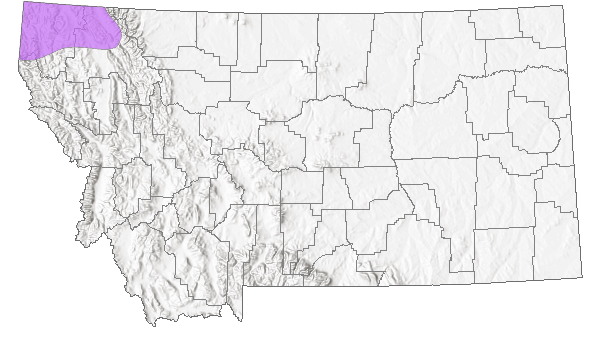
 Native
Native
Range Comments
Populations have been genetically and morphologically confirmed in the central and southern Rocky Mountain region of Western North America (Popovich et al. 2020). Plants have been found from Alberta, Canada south to Montana, Wyoming, Colorado, and New Mexico, USA (Popovich et al. 2020). Outlying populations occur to the east in Cypress Hills of Saskatchewan, Canada and in the Black Hills of Wyoming and South Dakota, USA (Popovich et al. 2020).
Observations in Montana Natural Heritage Program Database
Number of Observations: 18
(Click on the following maps and charts to see full sized version)
Map Help and Descriptions
Relative Density
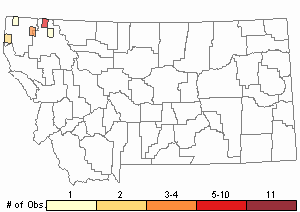
Recency
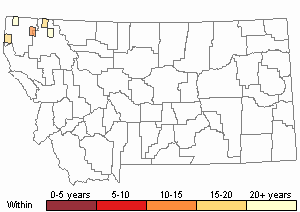

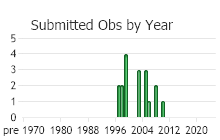
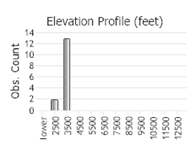 (Observations spanning multiple months or years are excluded from time charts)
(Observations spanning multiple months or years are excluded from time charts)
Habitat
Across its range plants occur in montane to subalpine meadows and forest openings, or at high latitudes can be found in prairies (Popovich et al. 2020). Plants often occur where there are natural or manmade disturbances made by fire, snow slides, retired mining districts, roadsides, or ski runs that are more than 20 years old and where the vegetation's succession has proceeded to a dominance of perennial herbs and grasses, but not to canopy closure by woody plants (Popovich et al. 2020). Elevations range from 1,235 meters in the Cypress Hills of Saskatchewan to 3,609 meters in New Mexico.
Ecological Systems Associated with this Species
- Commonly Associated with these Ecological Systems
Grassland Systems
Reproductive Characteristics
Plants reproduce by spores.
SPORANGIA
Sporangia are (8) 40-50 (to more than 200) in number, partially embedded, not crowded, and dull yellow at spore release (Popovich et al. 2020). Spores average 43.02 microns and range from (39) 41-45 (49) microns - as measured by the longest diameter (Popovich et al. 2020). Spores are apparently tetraploid (Popovich et al. 2020).
Stewardship Responsibility
References
- Literature Cited AboveLegend:
 View Online Publication
View Online Publication Lesica, P., M.T. Lavin, and P.F. Stickney. 2012. Manual of Montana Vascular Plants. Fort Worth, TX: BRIT Press. viii + 771 p.
Lesica, P., M.T. Lavin, and P.F. Stickney. 2012. Manual of Montana Vascular Plants. Fort Worth, TX: BRIT Press. viii + 771 p. Popovich, S.J. and D.R. Farrar. 2020. Botrychium furculatum (Ophioglossaceae), a New Moonwort Species from the Rocky Mountains of North America. American Fern Journal 110(4):165–182.
Popovich, S.J. and D.R. Farrar. 2020. Botrychium furculatum (Ophioglossaceae), a New Moonwort Species from the Rocky Mountains of North America. American Fern Journal 110(4):165–182.
- Additional ReferencesLegend:
 View Online Publication
View Online Publication
Do you know of a citation we're missing? Farrar, Donald. 2011. Moonwort (Botrychium) Systematics. Ada Hayden Herbarium. Iowa State University.
Farrar, Donald. 2011. Moonwort (Botrychium) Systematics. Ada Hayden Herbarium. Iowa State University. Lesica, P., M.T. Lavin, and P.F. Stickney. 2022. Manual of Montana Vascular Plants, Second Edition. Fort Worth, TX: BRIT Press. viii + 779 p.
Lesica, P., M.T. Lavin, and P.F. Stickney. 2022. Manual of Montana Vascular Plants, Second Edition. Fort Worth, TX: BRIT Press. viii + 779 p. Lesica, P., P. Husby, and S. V. Cooper. 1998. Noteworthy collections: Montana. Madrono 45:328-330.
Lesica, P., P. Husby, and S. V. Cooper. 1998. Noteworthy collections: Montana. Madrono 45:328-330. Wagner, W. H. and F. S. Wagner. 1993. Ophioglossaceae. In: Flora of North America Editorial Committee, eds. 1993. Flora of North America North of Mexico. 3+ vols. New York and Oxford. Vol. 2, pp. 85-106.
Wagner, W. H. and F. S. Wagner. 1993. Ophioglossaceae. In: Flora of North America Editorial Committee, eds. 1993. Flora of North America North of Mexico. 3+ vols. New York and Oxford. Vol. 2, pp. 85-106. Wagner, W. H., Jr. and F. S. Wagner. 1990. Notes on the fan-leaflet group of moonworts in North America with descriptions of two new members. American Fern Journal 80:73-81.
Wagner, W. H., Jr. and F. S. Wagner. 1990. Notes on the fan-leaflet group of moonworts in North America with descriptions of two new members. American Fern Journal 80:73-81.
- Web Search Engines for Articles on "Wishbone Moonwort"





